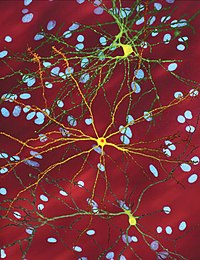
Photo from wikipedia
Abstract Age-associated neurodegenerative diseases, such as Alzheimer’s disease, Parkinson’s disease, and the polyglutamine (polyQ) diseases, are becoming prevalent as a consequence of elongation of the human lifespan. Although various rodent… Click to show full abstract
Abstract Age-associated neurodegenerative diseases, such as Alzheimer’s disease, Parkinson’s disease, and the polyglutamine (polyQ) diseases, are becoming prevalent as a consequence of elongation of the human lifespan. Although various rodent models have been developed to study and overcome these diseases, they have limitations in their translational research utility owing to differences from humans in brain structure and function and in drug metabolism. Here, we generated a transgenic marmoset model of the polyQ diseases, showing progressive neurological symptoms including motor impairment. Seven transgenic marmosets were produced by lentiviral introduction of the human ataxin 3 gene with 120 CAG repeats encoding an expanded polyQ stretch. Although all offspring showed no neurological symptoms at birth, three marmosets with higher transgene expression developed neurological symptoms of varying degrees at 3–4 months after birth, followed by gradual decreases in body weight gain, spontaneous activity, and grip strength, indicating time-dependent disease progression. Pathological examinations revealed neurodegeneration and intranuclear polyQ protein inclusions accompanied by gliosis, which recapitulate the neuropathological features of polyQ disease patients. Consistent with neuronal loss in the cerebellum, brain MRI analyses in one living symptomatic marmoset detected enlargement of the fourth ventricle, which suggests cerebellar atrophy. Notably, successful germline transgene transmission was confirmed in the second-generation offspring derived from the symptomatic transgenic marmoset gamete. Because the accumulation of abnormal proteins is a shared pathomechanism among various neurodegenerative diseases, we suggest that this new marmoset model will contribute toward elucidating the pathomechanisms of and developing clinically applicable therapies for neurodegenerative diseases.
Journal Title: eNeuro
Year Published: 2017
Link to full text (if available)
Share on Social Media: Sign Up to like & get
recommendations!